OKX Trading Guide 2024: How to Trade on OKX

OKX is a leader in Web3 innovation and is a fantastic cryptocurrency exchange, supporting hundreds of altcoins and offering the ability to buy crypto with Visa, bank transfer, MasterCard, and Apple Pay. OKX has become one of the fastest-growing exchanges in the world thanks to their professional-grade trading and matching engine, huge selection of tradeable assets and rock-bottom fees.
OKX is a global and highly sought-after cryptocurrency exchange. Following its rebranding to OKX (formerly OKEX), the exchange has expanded to offer several DeFi-centric features alongside its expansive array of trade products. In light of these developments, we have created this OKX trading guide to help you easily navigate the exchange. For crypto trading novices, this guide is a primer on registering and efficiently using the features and services of the OKX exchange.
As a guide on using the OKX exchange, this piece does not delve deep into some of the exchange’s technical features, like OKX Earn. Coin Bureau has dedicated several standalone pieces to cover such topics in depth. I encourage you to check out these articles:
- OKX Complete Review
- Singing up on OKX
- How to buy Bitcoin on OKX
- OKX Earn Review
- OKX Wallet Review
- OKX Loans Review
- OKX Security Overview
- OKB Token Analysis
- OKX App Pros & Cons
- OKX NFT Marketplace Review
OKX Overview
OKX is a Seychelles-headquartered global cryptocurrency exchange operating in over 100 countries. It commenced operations in 2016 and serves retail and institutional investors.
The exchange’s initial focus was around the crypto spot and derivatives market. In 2022, it rebranded from OKEX to venture into DeFi frontiers. Following the rebranding, OKX developed an NFT marketplace, offered new GameFi and Metaverse products, and ventured into staking. OKX also boasts a robust, publicly verifiable Proof-of-Reserves strategy, ensuring the safety of user deposits.
Getting Started With OKX Trading
The first step to using any centralized exchange like OKX is creating an account using credentials like email or phone number. Once registered, crypto exchanges also demand users comply with their KYC (Know Your Customer) standards.
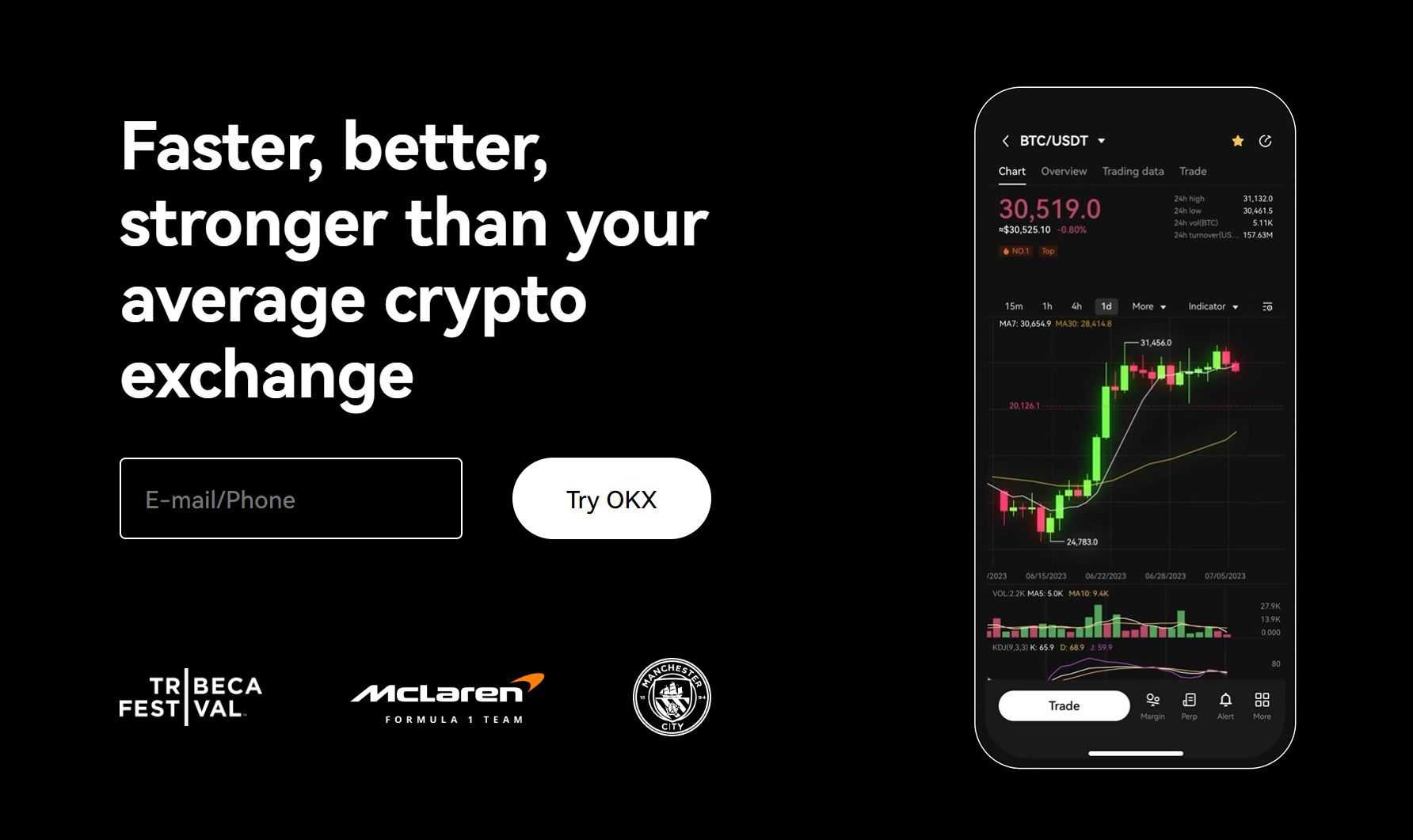
Once registered, you can deposit funds through fiat or crypto channels and use them to trade cryptocurrencies, participate in DeFi, or buy NFTs on the exchange. Let's get into these steps in detail.
Account Registration
Registering an account with OKX is an essential first step to using the exchange. You need a secure email or a phone number to create an account on OKX.
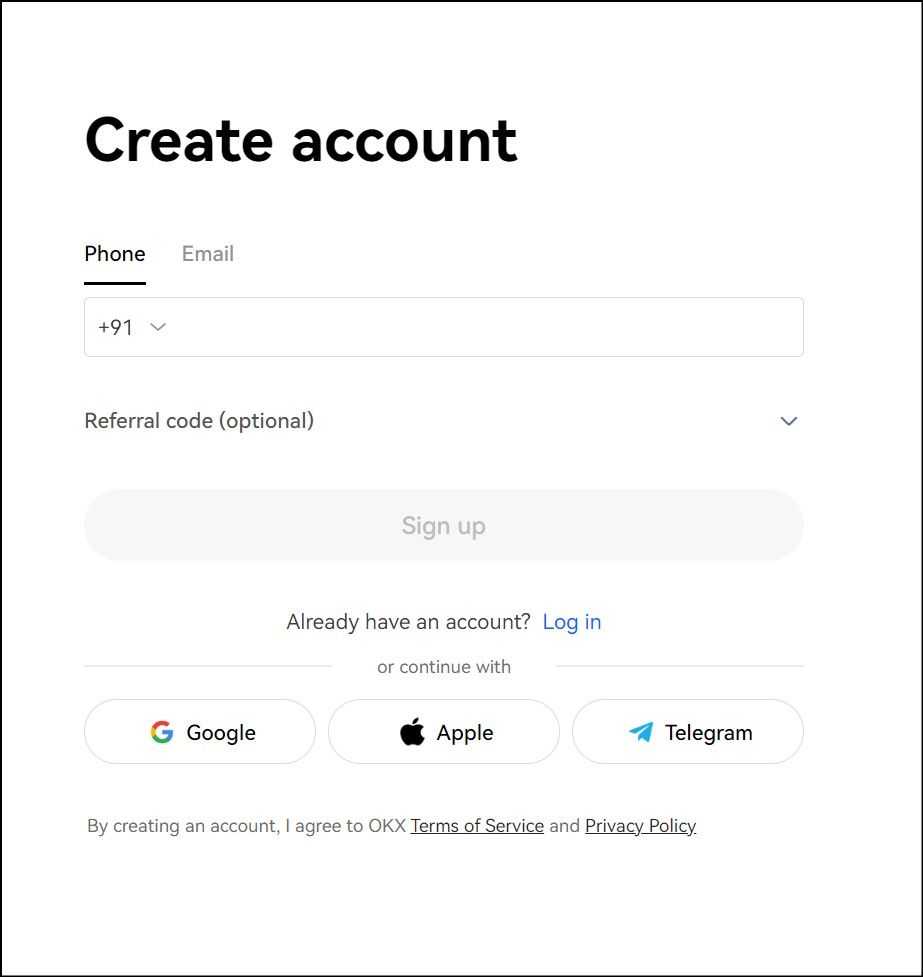
Here are the steps to follow:
- Singing up: Find the ‘Sign Up’ button on the exchange homepage at the bar on the top of the screen.
- Fill in the details: Sign up with a secure email address or phone number. You can also sign up with your Google or Apple account directly.
- Terms of Use: OKX assumes you accept their terms of use when you sign up. Therefore, make sure to read it thoroughly before confirming your details.
- Complete the verification: OKX will send a verification code to your registered email/phone. Use the code to complete the signing-up process.
- Specify your country: OKX will ask for your residence country. Make sure you provide the same country as your KYC verification details.
Verify Your Identity
Like every other major centralized cryptocurrency exchange, OKX requires you to complete KYC requirements to unlock all their exchange features and services. You may identify your account as:
- Individual - Provide personal identity information.
- Institution - Provide legal documents of your institution’s incorporation and operations.
The individual verification process entails providing a national ID, a selfie, and a Proof of Address (if applicable). After completing the process in just five minutes, I had a smooth experience verifying my identity. Here are some tips to ensure quick verification:
- Use your phone to verify; you don’t have to install the OKX app.
- Ensure sufficient lighting in the room where you take selfies and ID pictures.
- Use a standard ID, like your driver’s license.
Depositing Funds
You need funds to access any service or trade on OKX. There are multiple deposit options to choose between; they span both fiat and crypto pathways. Let's explore them one by one.
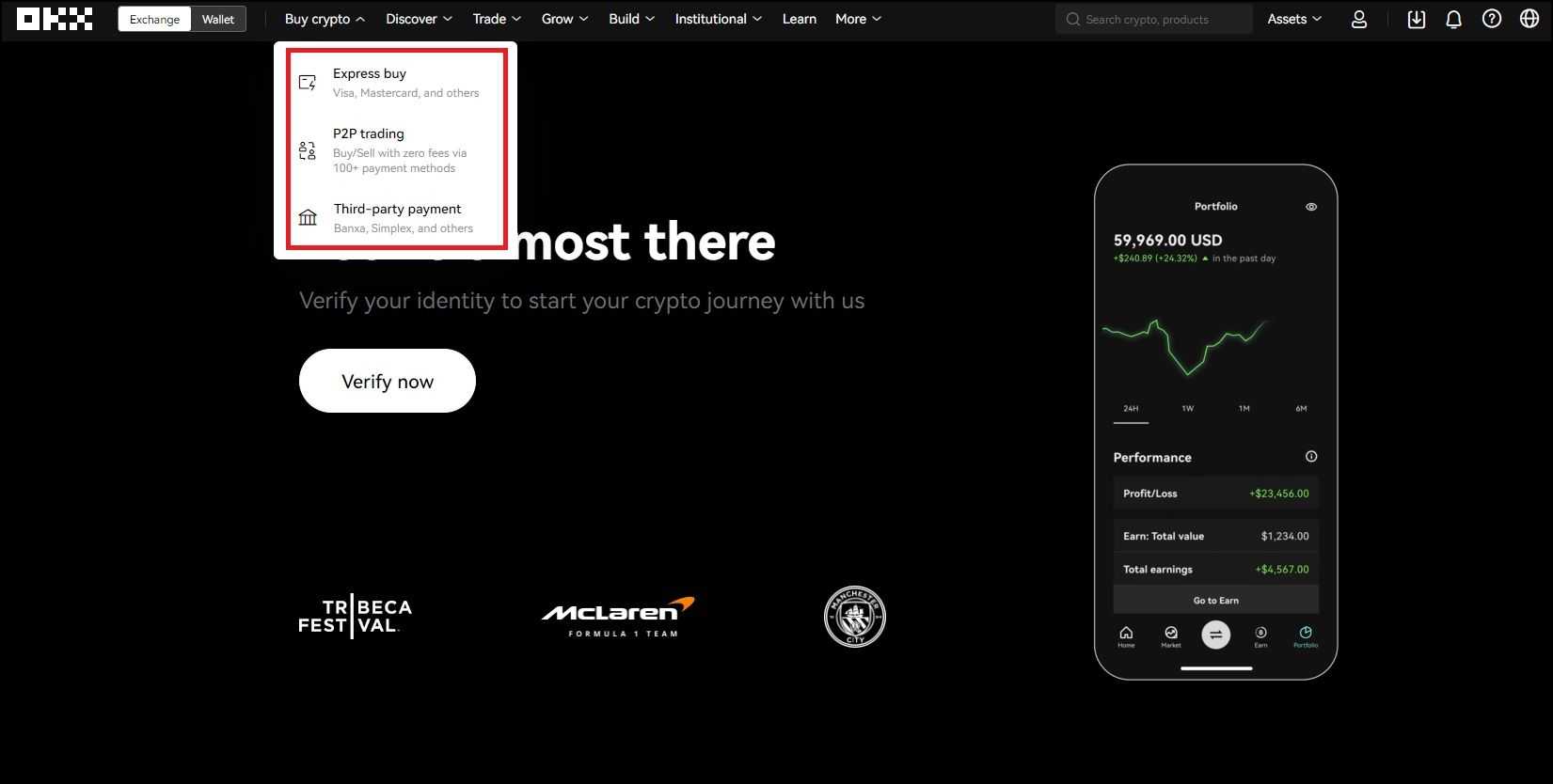
Buy Crypto With Fiat
Find the ‘Buy crypto’ tab on the bar at the top. The drop-down menu lists three fiat options to buy crypto:
- Express buy - This option lets you buy (or sell) select cryptocurrencies with fiat currency. Express Buy supports over 90 fiat currencies and prominent payment channels like Visa, Mastercard, and Apple Pay.
- P2P trading - OKX connects you with crypto buyers and sellers over fiat channels and mediates the transaction. Here, you pay the party directly. Traders generally use P2P trading with stablecoins.
- Third-party payment - Institutions like Banxa and Xanpool support cryptocurrency orders on OKX. Please note that these are external parties beyond OKX’s control.
Please note that fiat channels for buying cryptocurrencies are only supported in some places, so you must check if they are in your country. Select the most comfortable option and follow the corresponding payment gateways to complete your order.
Make On-Chain Crypto Deposits
The exchange also supports on-chain deposits if you already have some cryptocurrencies in an on-chain address that you want to move to OKX. Find the ‘Assets’ tab on the top-right. From the drop-down menu, select ‘Deposit’ to reach the deposits window.
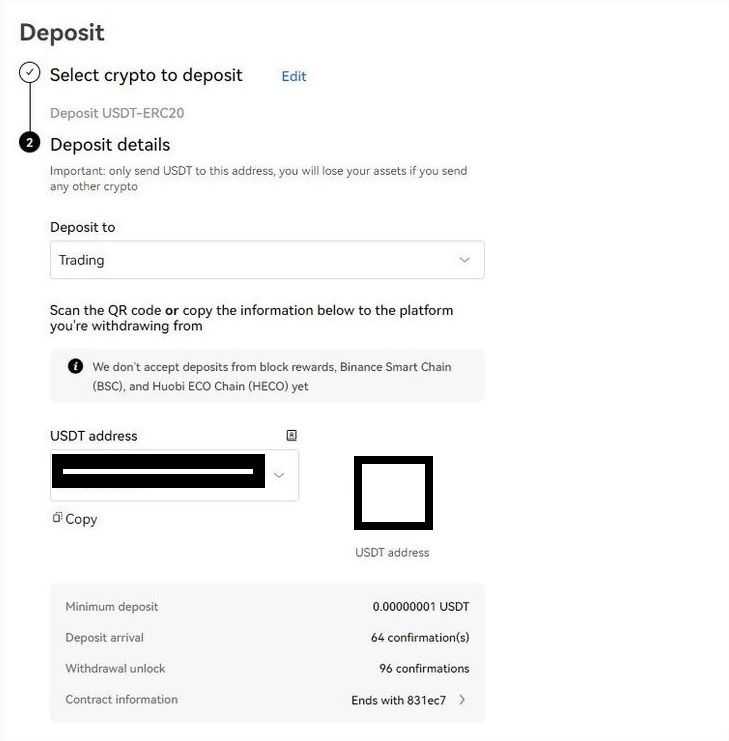
Follow these steps to make the deposit:
- Select the cryptocurrency you want to deposit.
- Select the network where you will deposit the cryptocurrency from, which is the network where your funds currently reside, and then click next.
- Select the desired OKX account. The ‘Trading’ account is used for spot trading, while the ‘Funding’ account is dedicated to products like OKX Earn.
- Send the funds to the address provided by the exchange and wait for confirmation. The selected OKX account will reflect the funds momentarily.
Place Your First Trade
Now that you have some funds in your account, you can begin trading cryptocurrencies. Find the ‘Trade’ tab from the bar at the top. The drop-down menu lists several beginner and advanced trading options. Let’s discuss a few basic trading strategies to get you up to speed.
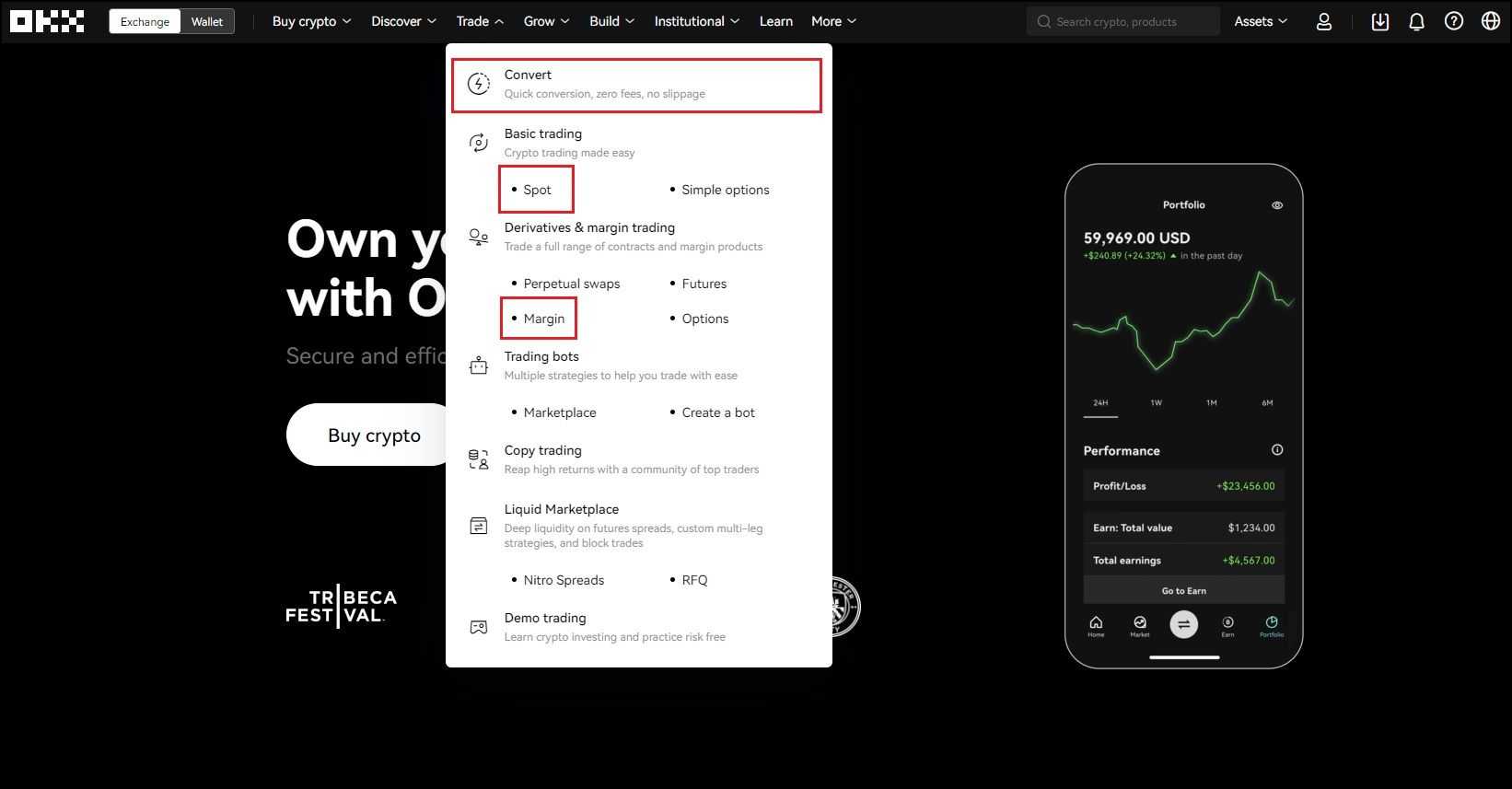
OKX Convert
Convert is a straightforward feature for folks who want to swap one cryptocurrency for another. Convert is most conventionally used for exchanging stablecoins for coins like BTC, ETH, or DOGE. OKX Convert swaps the selected cryptocurrencies instantly and at market price, circumventing advanced features offered in the spot trading portal.
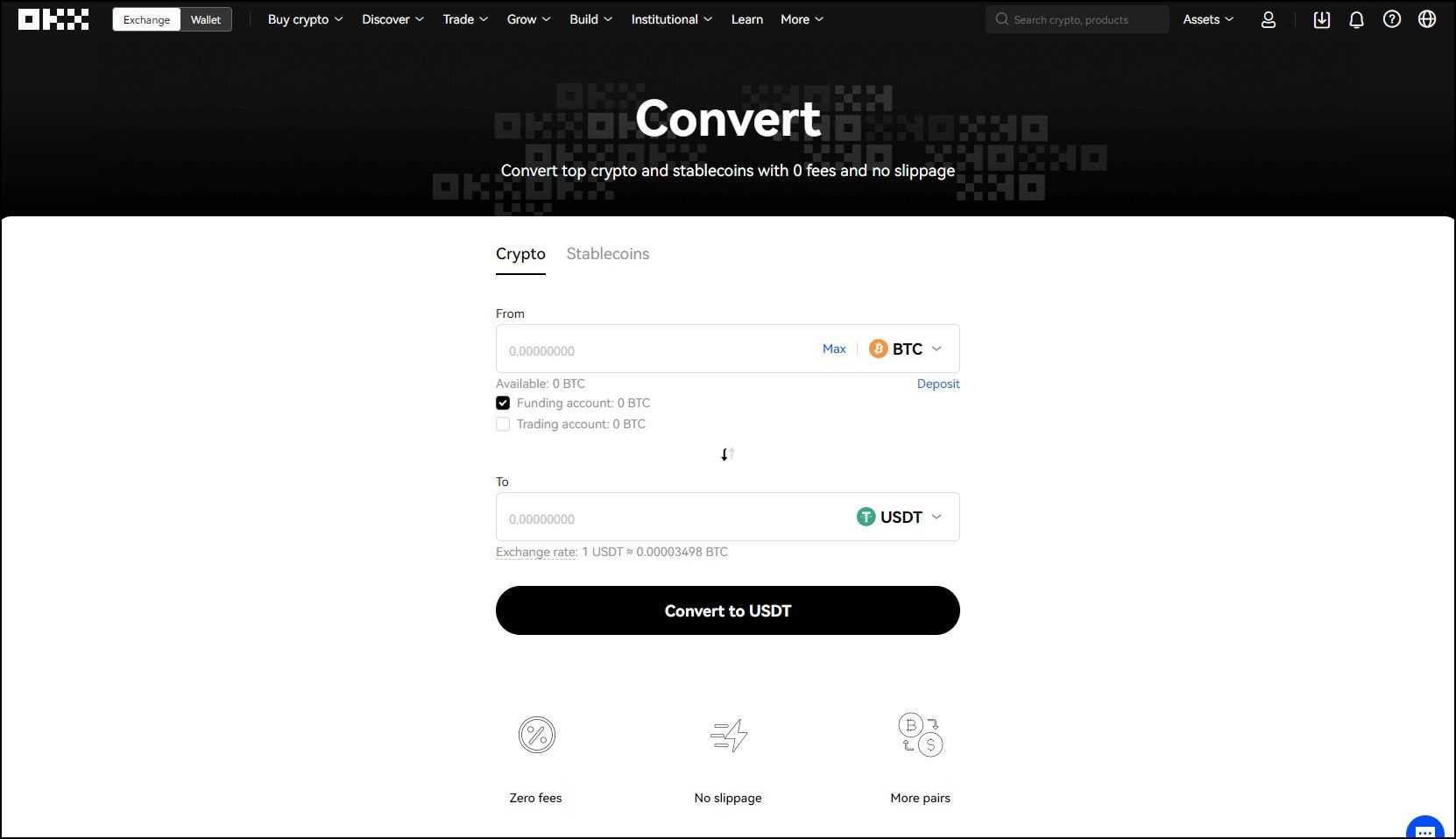
The Convert feature is great for beginner traders or any who doesn't need to access a charting interface to perform technical analysis.
Spot Trading
Spot is the financial market where assets are traded for instant delivery and settlement. Access the spot market on OKX from the ‘Trade’ tab at the top bar.
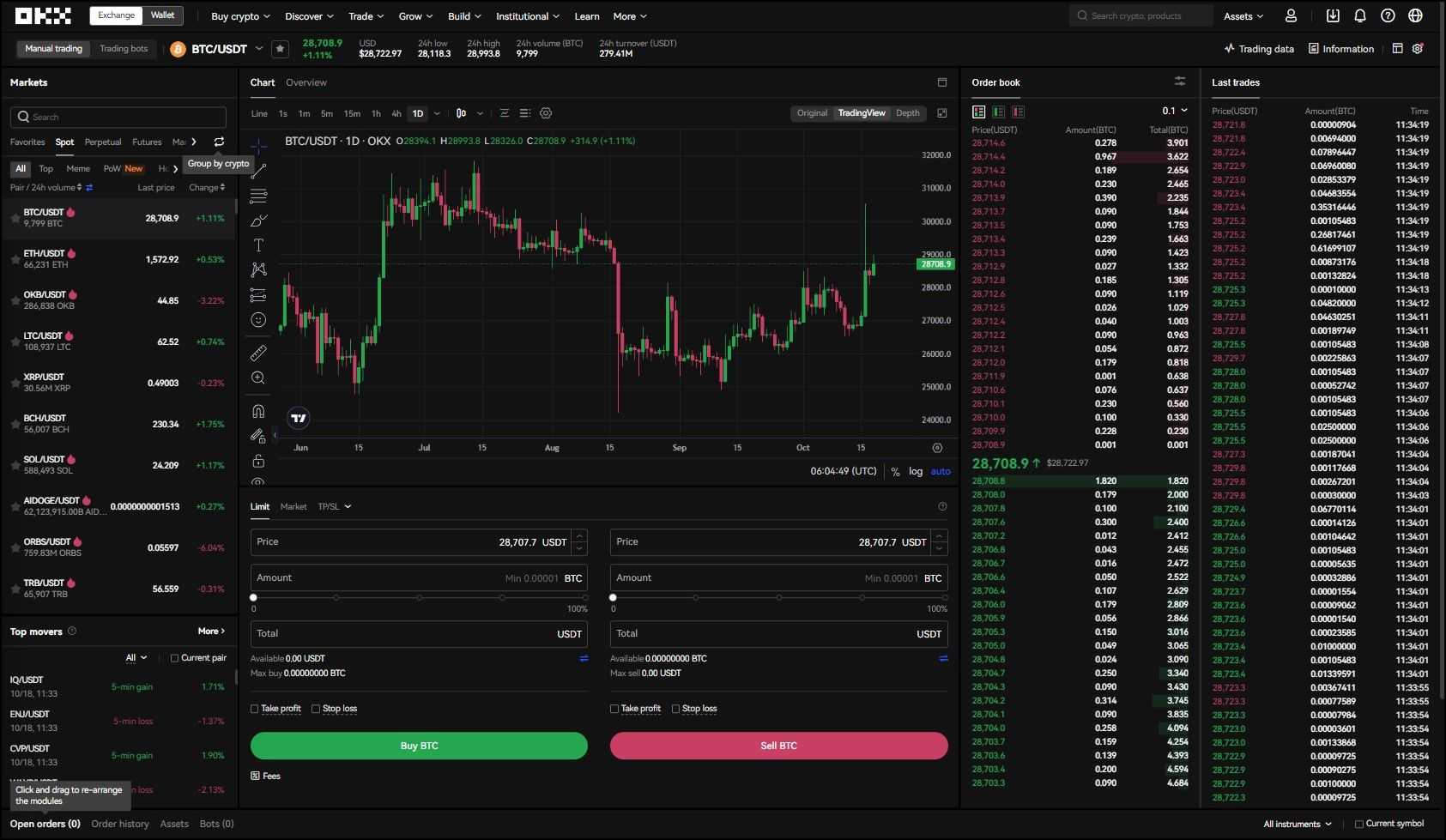
This is what the Spot trading screen looks like on the OKX exchange. Let’s break it down to understand its several elements:
- Header - The row above the price chart summarizes essential details about the asset, like the trading pair, the current price, highs and lows. You can observe the BTC/USDT pair in the picture above.
- Chart - The candlestick chart displays the price history of the selected pair. Adjust the time frame for a broader/narrower view based on your trading strategy, and use the available drawing tools and indicators to deduce price patterns. TradingView provides the price charts on the OKX exchange.
- Order book - The order book is on the price chart's immediate right. It displays volumes of buy or sell orders from other traders at different price levels. The order book summarizes all the trader’s sentiment, known as market depth.
- Order window - You can place buy or sell orders on the trading window below the price chart. A BTC/USDT buy order purchases BTC for USDT and vice versa. OKX supports several crypto-stablecoin or crypto-crypto trading pairs.
Order Types
In the Spot market, traders have the flexibility to place buy or sell orders at their chosen prices, forming a collective order book. Orders remain pending until their specified price aligns with the prevailing market rate. At this stage, the exchange pairs a buyer with a seller (or vice versa) to carry out the trade.
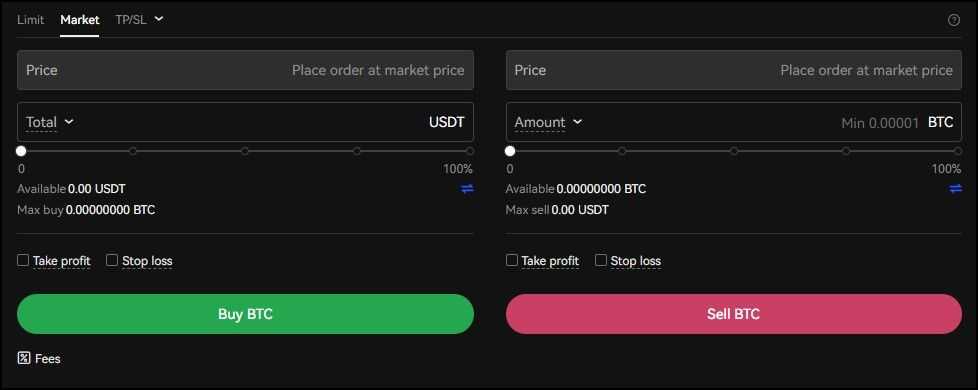
Traders can customize their orders to execute only when certain conditions about the trade are met. The exchange holds the order for the traders, so they don’t have to be online to manage them. There are three types of orders available on OKX:
- Market - Akin to the convert feature, market orders conduct immediate swaps at the current market price.
- Limit orders - Traders set their desired amount and price at which they want to execute trades. The order is on hold until the market meets those conditions.
- Stop orders - It offers further order customizability by offering secondary conditions the market must meet to open the orders.
- Limit orders - In a limit order, the trader specifies the amount of assets and the price they wish to buy. Placing the order locks the necessary funds, and the order executes only when the market meets the specified conditions.
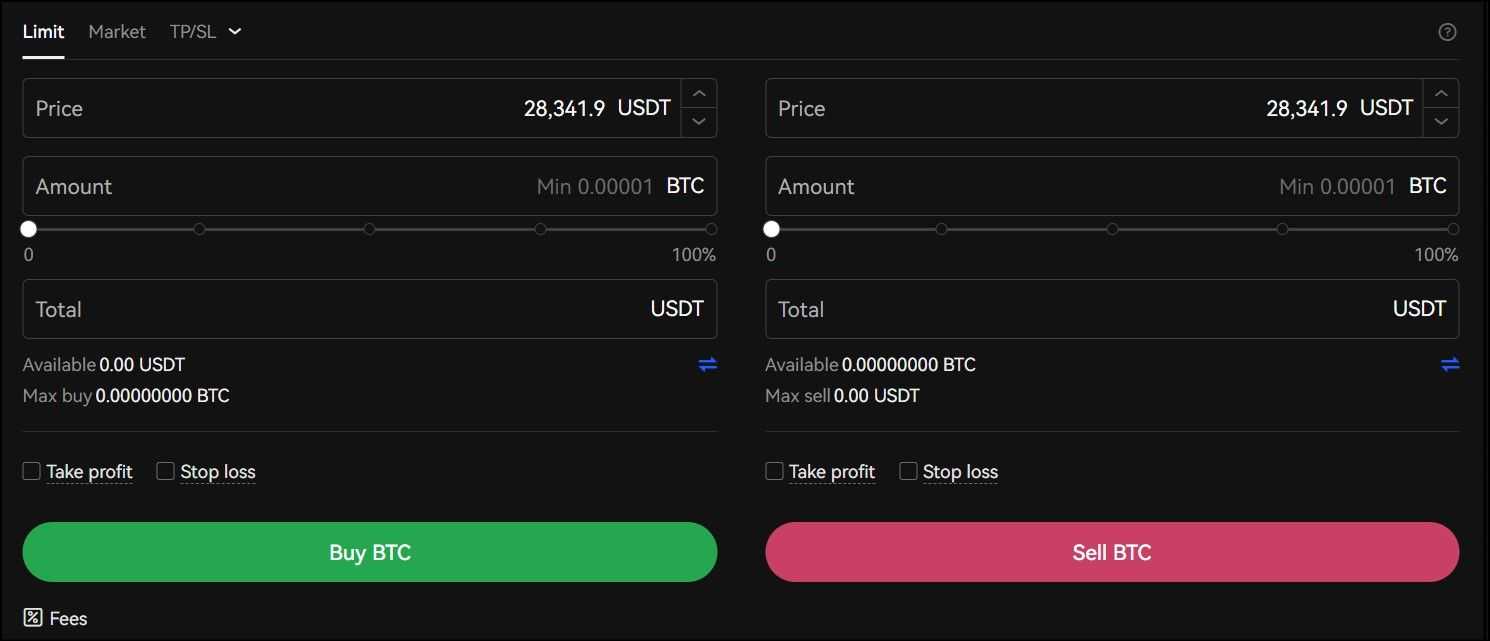
Stop Order Types
A stop order lets a trader open a spot position only when the market meets a particular condition about the asset price. Stop orders are convenient when you have a bullish or bearish sentiment over an asset only when the price hits a threshold. OKX supports the following stop orders:
TPSL (Take Profit and Stop Loss) Orders - A TPSL order asks the trader to set a trigger price, an order price, and an order amount. The exchange opens the order only when the asset price hits the trigger price. Once triggered, the TPSL order behaves like a limit order. OKX also lets users set the limit at market, meaning the order executes at the best price after getting triggered.
OKX also lets users set TPSL orders as conditional or OCO (One Cancels the Other). An OCO order enables the trader to specify two positions simultaneously. The idea is to place an order if the market moves in the trader's direction favourably and to cut losses otherwise.
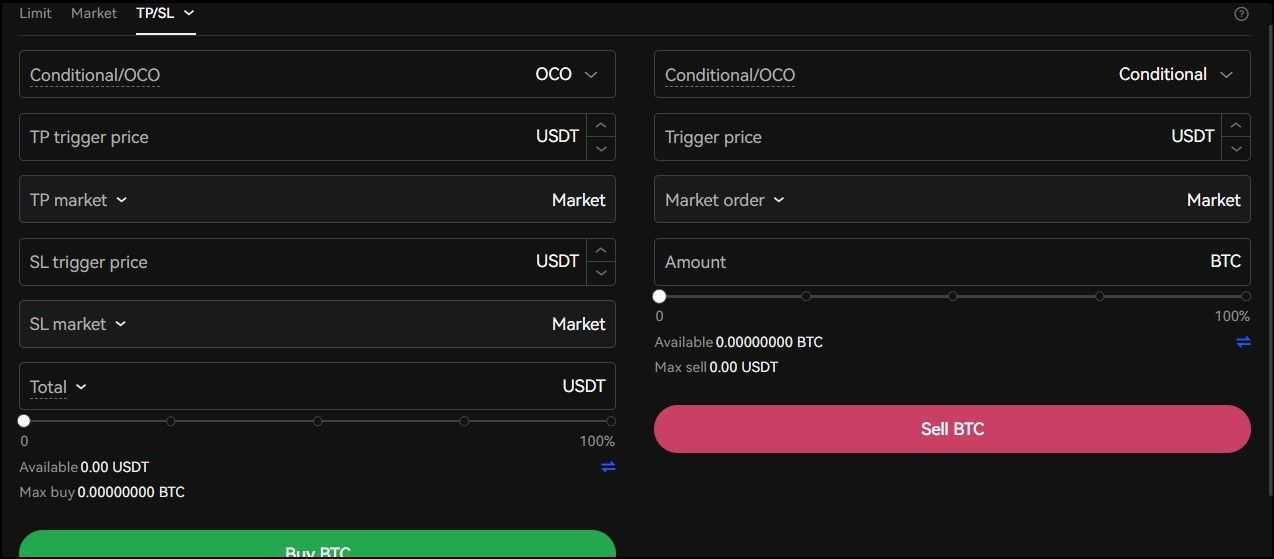
The speciality of an OCO order is that once it executes an order in one direction, it automatically cancels the order in the other direction. Traders need to enter the following values here:
- Amount - The amount of assets you wish to trade.
- TP trigger price - The trigger price to open the take profit order.
- TP price - The price at which to take profit (you can also set it at market).
- SL trigger price - The trigger price for the stop loss order.
- SL price - The price at which you want to cut losses (you can also set it at market price).
Trailing Stop - A trailing stop order lets you place an order that ‘trails’ the asset price when it is trending in a favourable direction and exits the position of the trend changes direction. The order consists of three values — activation price, variance, and amount.
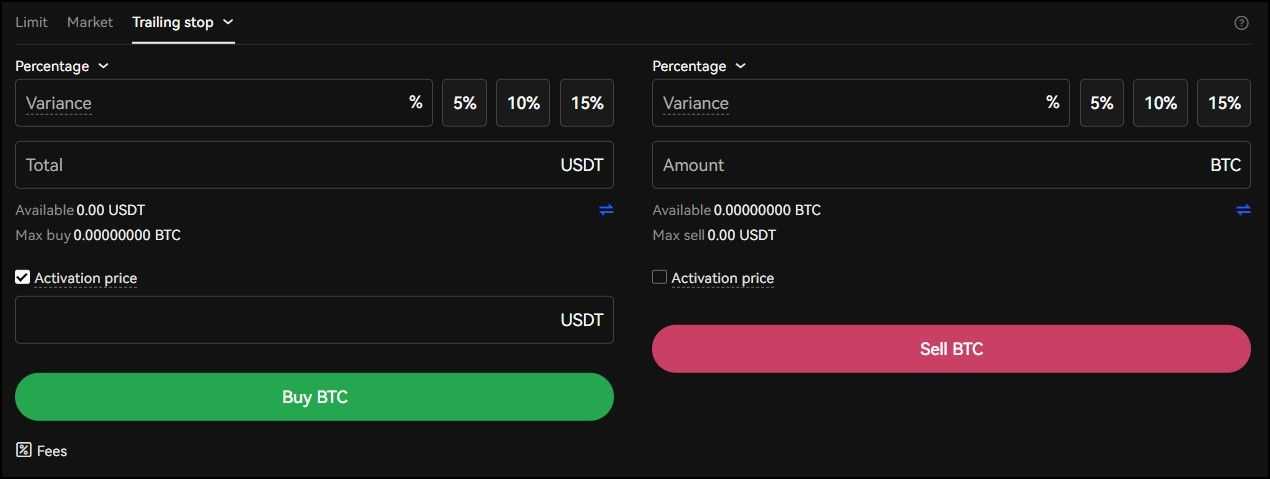
Margin Trading
Margin trading involves investors trading with borrowed funds from the exchange, allowing them to trade with more capital than they have on hand, creating a high-risk, high-reward scenario. The term "Margin" pertains to the collateral the trader provides, while "leverage" describes the increased buying power they gain.
The process of margin trading begins with the trader depositing collateral into their margin account with the exchange. Depending on the broker's terms, the trader can borrow funds from the exchange, typically at multiples of their deposited margin, ranging from 2x to a highly risky 100x. To safeguard its loan, the exchange retains the right to close the trader's open positions and recover its funds if the market moves unfavourably for the trader; this is referred to as a margin call.
For example, a 2x leveraged position triggers a margin call if the value of the trader's margin account drops by half, considerably riskier than a spot position that remains open until the asset's value becomes zero. Conversely, if the market moves in the trader's favour, they can double their profit after repaying the exchange for the leverage and any accrued interest. OKX offers cross and isolated margin options with up to 10x leverage. The leverage may differ with every asset. Let’s understand cross and isolated margins:
Cross Margin: Cross margin combines collateral and various leveraged positions across multiple cryptocurrencies into a unified pool. Traders are limited to a single cross-margin account, with the account value representing the total worth of all margin positions held within it. In the event of a margin call, all positions within the account are liquidated. On the other hand, diversifying the portfolio can assist in risk management, as an appreciating asset can offset the volatility of a declining one. In cross-margin trading, leverage traders can open positions up to 10 times larger than the collateral they provide.
Isolated Margin: Isolated margin resembles cross margin in many ways, with the key distinction being that it confines trading to a single asset type. Traders have the flexibility to create multiple isolated margin accounts for different asset categories, each having distinct collateral and margin constraints. On OKX, traders can initiate positions up to 10 times the amount of collateral within an isolated margin account.
Warning ⚠️: Trading with Margin is high risk and recommended for experienced and professional traders only. Be sure to understand the dangers of leverage before utilizing this product.
OKX Trading Key Features
OKX offers several intuitive features and security guarantees, equating to an experience ideal for polished and novice traders. Some essential features are summarized here:
- Wide selection of cryptocurrencies - The exchange offers a wide range of cryptocurrencies for trading and lists new tokens frequently, providing traders with several trading options.
- Trading options - Apart from spot and margin trading, the exchange also supports futures and options, perpetual swaps, and several Earn products.
- Advanced trading tools - OKX provides seasoned traders with advanced technical analysis and trading tools.
- Security - OKX provides transparent Proof of Reserves and maintains 1:1 deposits to ensure adequate liquidity.
- DeFi Staking - OKX also offers staking services with funds in the user’s account.
- OKB Token - The OKX native token, OKB, offers its owners several security, financial, and utility services and passive earning services.
- NFT Marketplace - The exchange also hosts an NFT marketplace where users can buy well-known NFTs.
- User interface - The OKX exchange interface is simple for average users and offers the customizability experienced traders prefer.
Understanding OKX Fees
OKX charges some of the lowest fees in the industry. It adopts a tiered approach that depends on the number of OKB tokens the user owns. Holding more OKB promotes you to a higher tier and reduces trading fees. Here is a snapshot of the latest tiers at the time of writing. However, fees are subject to revisions, and I suggest you verify the latest value on the OKX Fees Page.
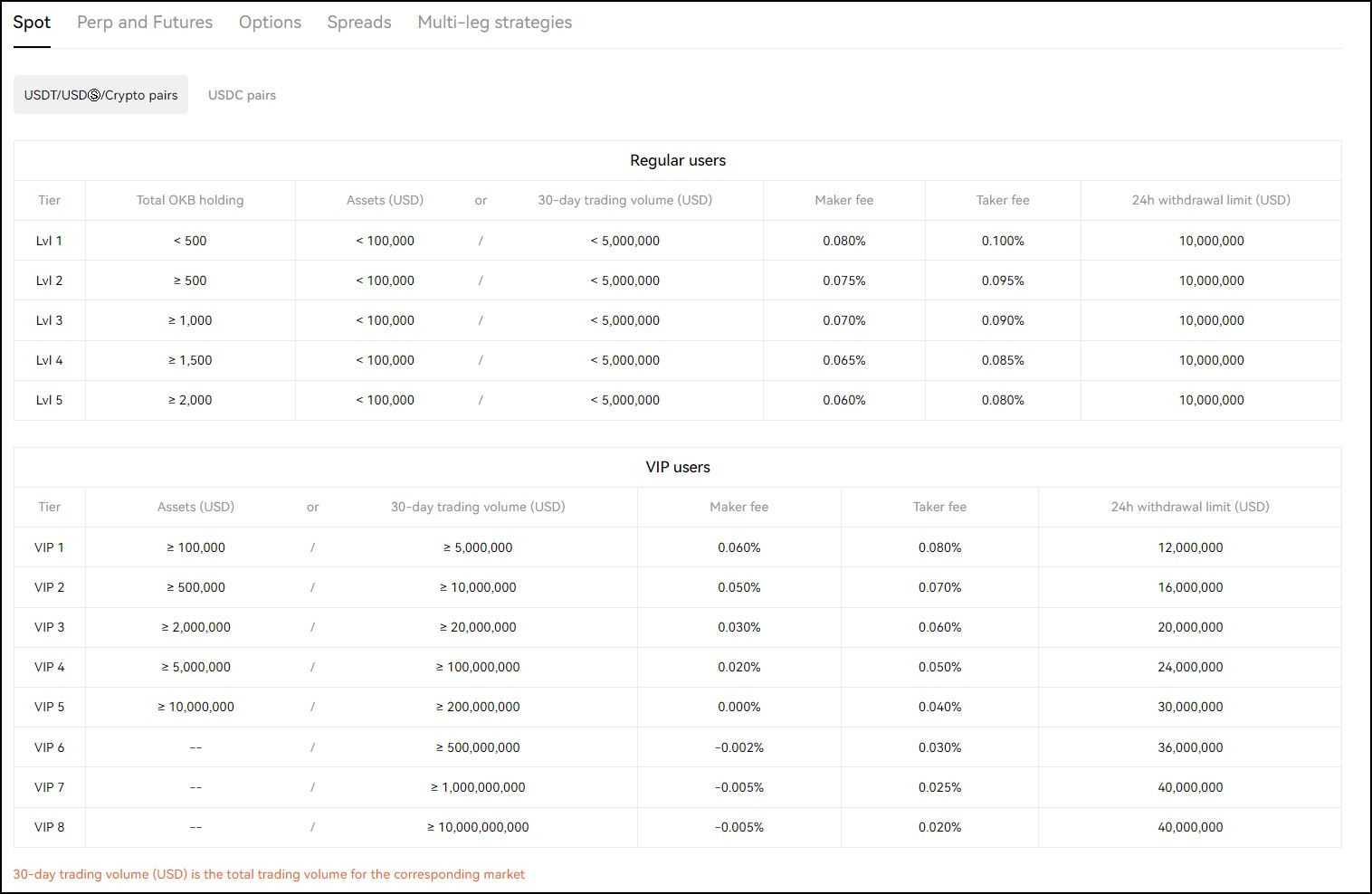
OKB Token
The OKB token is an ERC-20 token with a maximum supply of 300 million units. It is a utility token native to the OKX ecosystem and offers several benefits and discounts to its holders. Here is a summary of its benefits:
- Fee deduction - Exchange users can pay trading fees with the OKB token to benefit from up to 40% discount on trading fees.
- Access Jumpstart - OKX Jumpstart is a token sales platform where users can invest using the OKB token.
- Listing votings - Users can vote with OKB to have their favourite token listed on the exchange.
- External services - The OKB token unlocks several security, financial, and utility services from third parties.
- OKB Chain - The OKB Chain (OKBC) is a zkEVM layer-2 on Ethereum that deploys the OKB token as its settlement currency.
OKX Security and Trustworthiness
OKX boasts a robust security framework and has never fallen victim to any security breaches. It deploys several security measures at various levels, which are summarized below:
- Fund Storage - OKX holds 95% of its funds in offline cold wallets to protect them from attacks. The wallet access requires authorization from at least two security personnel. Therefore, the funds are stored in an acutely secure environment.
- OKX Risk Shield - OKX allocates a percentage of its earnings to an asset risk reserve fund.
- Mandatory 2FA - OKX mandates two-factor authentication, reducing the risk of user account hacks significantly.
- Secure Private Key Storage - OKX stores private keys in RAM instead of permanent memory for enhanced security.
- Emergency Backups - Multiple backup procedures adopted by OKX ensure optimum preparation for potential emergency scenarios.
As with any centralized financial service, individuals considering staking assets on OKX Earn or depositing assets on OKX accounts must exercise due diligence and clearly understand the associated risks.
We did a deep dive analysis on OKX security if you would like to know more. They have shown to be highly secure, transparent and trustworthy.
OKX Trading Tips for Beginners
Traders navigating the ever-evolving world of blockchain-based digital assets are immersed in a highly dynamic environment. It's essential for newcomers transitioning from traditional equities to cryptocurrencies to recognize that this unregulated market operates 24/7, allowing only a small window to respond to the often delicate shifts in sentiment.
With this in mind, gaining a comprehensive understanding of cryptocurrency fundamentals, including aspects like tokenomics becomes pivotal for long-term success in this market. Many traders begin by trading well-established, blue-chip crypto assets with the highest market capitalizations. These assets tend to exhibit more stability than other speculative cryptocurrencies, and their progress is readily traceable.
The Coin Bureau has thoughtfully compiled lists of top resource channels designed to enhance your knowledge of cryptocurrencies swiftly. Feel free to explore these valuable links below:
Leverage these resources to empower yourself with a solid foundation of knowledge about this industry, enabling you to perform thorough due diligence and make well-informed investment decisions within this market.
I also recommend checking out our Coin Bureau Trading channel on YouTube where our resident expert trader Dan provides great trading guides, trading setups, and analysis, along with tips and tricks for everyone from beginners to pros.
Risk Management
In my view, risk is a concept often misunderstood in investing. One common error novice traders make regarding the psychology of risk is perceiving it as an absolute, unchangeable element rather than a relative one. Most treading experts agree that psychology is one of the most important factors of trading, which is why we created this Guide for Mastering Trading Psychology.
Traders must shift their perspective on risk from something to avoid completely to a feature they can optimize. This perspective arises from the fact that the market inherently contains risk. In an entirely risk-free market scenario, all traders would be consistently bullish, and there would be no sellers, rendering a market non-existent.
Risk management involves the deliberate evaluation of the potential for a successful trade against possible losses in the event of an unfavourable outcome, leading to the optimization of one's trading strategy. Risk mitigation occurs through two primary approaches:
- Expanding your knowledge of the asset's fundamentals enables you to make more informed assessments of its potential value.
- Enhancing your understanding of market technicals allows you to strategically place orders that align with or counter prevailing market trends and hedge your positions.
A proficient trader effectively balances risk management by incorporating both of these strategies. With the provided links, you can delve into the essential fundamentals. Now, let's transition to delving deeper into understanding the technical aspects of trading:
Trend Analysis
Trend analysis involves comprehensively examining market movements, empirical data, accumulated experience, and psychological factors to determine optimal trade entry and exit points with the greatest likelihood of success. Educational resources such as Coin Bureau Trading can equip you with the skills to identify market patterns and independently analyze markets, reducing your dependence on third-party analyses. Here are some recommended sources to kickstart your journey:
Technical Analysis
Technical analysis is a technique employed in financial markets to forecast forthcoming price movements by examining historical price data and trading volume. It relies on the fundamental belief that historical price and volume data can offer valuable insights into the future trajectory of an asset's price.
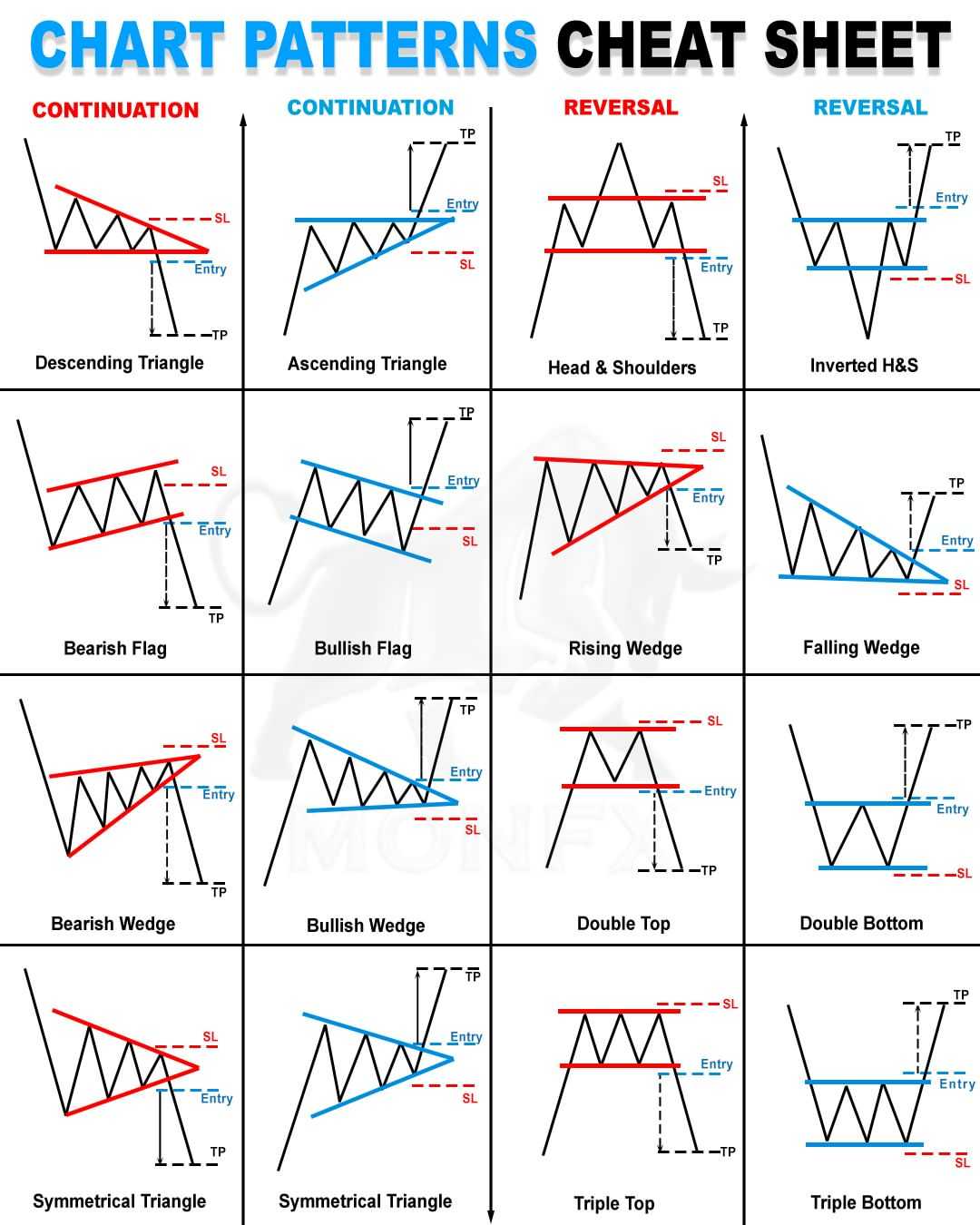
Technical indicators, essential tools in the field of technical analysis, are mathematical computations and visual representations that aid traders and investors in their decisions regarding the purchase or sale of financial assets. These indicators offer valuable insights into market trends, momentum, volatility, and potential turning points.
The three most widely accepted technical indicators are:
- Moving Average: A moving average is a widely used indicator that calculates the average price of an asset over a specified time frame. It helps traders identify trends by smoothing out price fluctuations, making it easier to spot the direction an asset's price is moving.
- Relative Strength Index (RSI): RSI is a momentum oscillator that measures the speed and magnitude of price changes. It oscillates between 0 and 100, with readings above 70 indicating overbought conditions and readings below 30 signalling oversold conditions. It helps traders assess potential trend reversals.
- Bollinger Bands: Bollinger Bands consist of a central moving average and two bands representing standard deviations from the average. They provide insights into an asset's volatility and potential price extremes. When the bands contract, it suggests lower volatility, while widening bands indicate increased volatility.
Traders often combine these indicators with other tools to make informed decisions.
OKX Trading Guide: Closing Thoughts
OKX proves to be an excellent choice for beginners seeking to enter the blockchain industry. Its user-friendly interface caters to novice traders while offering advanced features like dual investment, shark fin, futures, and options for those comfortable with a high-risk, high-reward environment.
In concluding this guide, it's essential to emphasize the significance of managing emotions like fear and greed in the speculative cryptocurrency market. You can manage greed effectively by mastering risk management tools and profoundly understanding the digital asset landscape. Such knowledge shields traders from being swayed by volatile fluctuations, irrational decisions, and potentially misleading advice from market experts.
Frequently Asked Questions
OKX is committed to security, employing measures like cold storage for funds and two-factor authentication for user accounts. While it's recognized for security within the cryptocurrency industry, users should conduct their due diligence and follow best practices for online security.
OKX provides a user-friendly interface for cryptocurrency trading. Users can deposit funds, place orders, and engage in spot, futures, and options trading. It's designed to accommodate traders of different experience levels.
OKX offers a user-friendly interface suitable for traders at various levels. It provides educational resources and support for beginners. However, traders should approach the market with caution and ensure they understand the risks. Beginners should have no issues learning the ropes at OKX, but if beginner-friendliness is your main priority, we would recommend checking out SwissBorg or Kraken.
OKX offers a variety of investment products, including spot trading, futures contracts, options trading, and staking services. These options cater to traders with different objectives, from basic trading to more advanced strategies and passive income generation.
Disclaimer: These are the writer’s opinions and should not be considered investment advice. Readers should do their own research.



